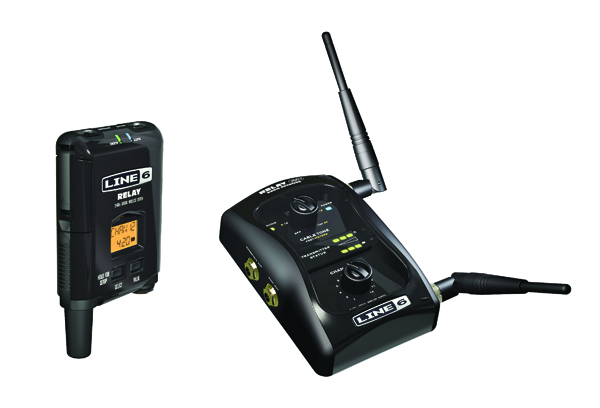Review: Line 6 Relay G30, G50, and G90 Digital Wireless Guitar Systems

Playing onstage with a wireless system without having to worry about getting tangled in cables is one of the most liberating experiences for a guitarist. The problem with many wireless systems is that they can compromise the integrity of a guitar’s tone by rolling off high- and low-end frequencies and compressing the signal somewhat. Line 6’s new Relay Series Digital Wireless Systems are designed to eliminate those problems, providing the same crystal-clear tone and dynamic feel as using a high-end guitar cable along with reliable, dropout- and static-free wireless performance in the most demanding onstage environments.
FEATURES
Line 6 currently offers three Relay wireless systems—the G90, G50 and G30—which primarily differ in the amount of channels (six for the G30, 12 for the G50 and G90) and range (G30: 100 feet; G50: 200 feet; G90: 300 feet) they offer. The G90 also has a rack-mountable receiver while the G50 and G30 come with compact, stomp box–style receivers. Receiver outputs include 1/4-inch (all), tuner pass-through (G50 and G90) and XLR (G90 only). The G50’s RXs12 receiver has multisegment LEDs for battery life and signal strength, while the G90’s RXR12 receiver provides an LCD for viewing channel number and battery-life data. The G30 system includes the TBP06 transmitter with a 1/4-inch unbalanced input jack, while the G50 and G90 offer the TBP12 transmitter with TA4F connectors (similar to an XLR connector but with four pins) and LCD display.
All three systems provide 2.4GHz RF carrier frequencies, 10Hz–20kHz frequency response and transmitter life of up to eight hours using two AA alkaline batteries. The receivers all include a Cable Tone Simulator feature with settings that emulate the tone of 15- or 30-foot cables or bypass the cable simulation section.
PERFORMANCE
The G30 and G50’s receivers are designed for mounting on a pedal board or on top of an amp, and they can be powered with a nine-volt DC adapter or multi-unit power supply. Setting up the system is very easy—simply match the transmitter’s channel number with receiver’s channel number and you’re good to go once you’ve pinpointed the channel with the strongest, most reliable signal. The Cable Tone Simulator’s 15- and 30-foot settings roll off just a hint of brightness, providing warm tones similar to longer cable runs. The range is better than the spec sheet specifies, and the sound and dynamics are actually better than many guitar cables.
THE BOTTOM LINE
Get The Pick Newsletter
All the latest guitar news, interviews, lessons, reviews, deals and more, direct to your inbox!
Line 6’s Relay Series wireless systems truly deliver the tone and dynamic response of playing with a guitar cable while eliminating the biggest hassles of using a wireless system onstage.
Chris is the co-author of Eruption - Conversations with Eddie Van Halen. He is a 40-year music industry veteran who started at Boardwalk Entertainment (Joan Jett, Night Ranger) and Roland US before becoming a guitar journalist in 1991. He has interviewed more than 600 artists, written more than 1,400 product reviews and contributed to Jeff Beck’s Beck 01: Hot Rods and Rock & Roll and Eric Clapton’s Six String Stories.
“Our answer to everything players have asked for and more”: Neural DSP’s Nano Cortex had one major drawback – but now it’s been addressed with a huge free firmware update that takes on Kemper and TONEX
“One of the most genuinely unique guitar tones I’ve ever heard”: Submarine Pickups Subsix review



![[from left] George Harrison with his Gretsch Country Gentleman, Norman Harris of Norman's Rare Guitars holds a gold-top Les Paul, John Fogerty with his legendary 1969 Rickenbacker](https://cdn.mos.cms.futurecdn.net/TuH3nuhn9etqjdn5sy4ntW.jpg)







